As a passionate dog owner, I know how nerve-wracking trimming a dog’s nails can be, especially if the quick has grown out too far. Overgrown quicks can lead to difficulties in nail trimming and even discomfort for your furry friend. If you’ve ever accidentally nicked the quick, you understand the guilt and pain your pooch goes through. But what if I told you there are ways to help the nail quick recede, ensuring safer and easier trims? Today, I’m diving deep into the world of canine nail care. We’ll explore the importance of timing and introduce three effective techniques to make your dog’s nail quick recede. Let’s embark on this journey together and make nail trims a stress-free task for both you and your furry companion!

Why Do You Need to Cut Your Dog’s Nails?
Having a dog is an immensely rewarding experience, and we always strive to ensure their well-being. One aspect of dog care that might not always get its due attention is nail trimming. But, why is it so important? Let’s delve into some key reasons.
1. Preventing Overgrowth
Long nails can become overgrown, curling back into your dog’s paw pads. This can be painful and lead to infections. Regular trims ensure that nails remain at a healthy length, preventing these complications.
2. Comfort and Posture
Imagine walking around with shoes that don’t fit, and you’ll get an idea of how a dog might feel with long nails. Overly long nails can change the alignment of a dog’s foot. Over time, this can lead to posture problems and even arthritis in older dogs.
3. Reducing the Risk of Injuries
Active dogs with long nails can easily snag them on carpets, furniture, or outdoor elements. This not only risks damaging your belongings but more importantly, it can cause painful tears in the nail or even injuries to the paw.
4. Avoiding Quick Overgrowth
The ‘quick’ of the nail, which supplies blood to the nail, tends to grow along with the nail. Regular trims keep the quick shorter, making nail cutting easier and reducing the risk of accidentally cutting the quick.
5. Bonding Time
Though it might take some getting used to, nail trimming sessions can become a bonding activity. With positive reinforcement and a gentle approach, your dog can learn to trust and even enjoy these moments with you.
Regular nail trims are about more than just aesthetics. They’re a key aspect of comprehensive dog care, ensuring comfort, health, and a happy pup!
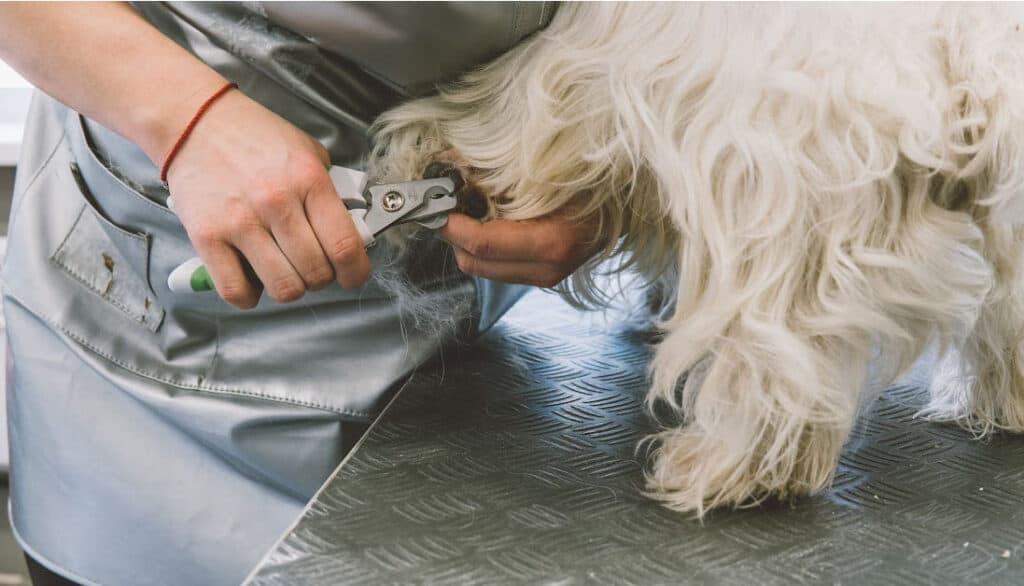
How to Tell if Your Dog’s Nails Are Too Long
As a dog owner, it’s crucial to understand when your dog’s nails have reached an excessive length. Long nails can lead to a multitude of problems, from simple discomfort to potential health issues. But how can you tell? Let’s explore some telltale signs.
- Clicking Sounds on Hard Surfaces: One of the most noticeable indicators is the sound of your dog’s nails clicking on hard surfaces, like tile or hardwood floors. If you can hear them tapping away as they walk, it’s probably time for a trim.
- Altered Walking or Standing Posture: If you notice your dog standing or walking in an unusual manner, long nails might be the culprit. Dogs may adjust their posture to avoid pain from overgrown nails, which can look like they are “tiptoeing.
- Visual Check: If you can see the nails curling when looking at your dog from the side or if they touch the ground when your dog is standing still, they’re too long.
- Discomfort or Pain: Dogs might chew on their nails or lick their paws excessively if their nails are causing discomfort. They might also show signs of pain when walking or running.
How to Identify a Dog’s Quick
Recognizing the quick in a dog’s nail is crucial to safe and effective trimming. Here’s how you can spot it:
- Color Differences: On light-colored nails, the quick is the pinkish section in the middle of the nail. For darker nails, you might have to rely on other methods.
- Nail Profile: If you look at the nail’s cross-section, you’ll notice it’s comprised of two parts: a hard outer shell and a softer center. The softer center is where the quick resides.
- Feel: As you start trimming the nail, you’ll first cut through the hard part. Once you get closer to the quick, the nail will feel spongier.

Why Does the Quick Overgrow?
Understanding why the quick grows is pivotal in preventive care. So why does it get long?
- Infrequent Trimming: Regular nail trimming can prevent the quick from extending too far. When nails aren’t cut frequently, the quick tends to grow with the nail.
- Age and Health: Just like in humans, as dogs age, their nails can grow faster. Some health conditions might also influence nail and quick growth.
- Genetics: Some breeds naturally have longer quicks than others.
- Inactivity: Dogs that spend a lot of time indoors or on soft surfaces don’t experience the natural nail wear that can keep nails short.
Regularly monitoring the state of your dog’s nails and understanding the anatomy will ensure you provide the best care possible, preventing potential pain and discomfort. Always approach nail trimming with caution and knowledge to ensure a positive experience for your pup!

Lessons From a Groomer: Nail Clipping, Ear Cleaning, and Baths
Groomers are like the unsung heroes of the canine world, ensuring our fur-babies look and feel their best. Having spent years handling all shapes and sizes of dogs, groomers pick up a myriad of tips and tricks. Today, we’re diving into some invaluable lessons from seasoned groomers on nail clipping, ear cleaning, and the art of the perfect doggy bath.
Nail Clipping: Not Just About Length
- Tools Matter: Invest in a good pair of dog nail clippers. A sharp, high-quality pair will make the process smoother for both you and your pet.
- Stay Calm and Reward: Your energy affects your dog. Stay calm, speak in soothing tones, and reward your dog after the session.
- Know Your Dog’s Limits: Some dogs can only handle a few nails at a time. It’s okay to spread out the trimming sessions over several days.
- Get a Good Angle: Aim to clip at a 45-degree angle, just above where the nail starts to curve.
Ear Cleaning: Delicate But Necessary
- Use the Right Solution: Invest in a vet-recommended ear cleaning solution. Avoid using water as it doesn’t evaporate easily and can lead to infections.
- Cotton Balls, Not Q-tips: Cotton balls can effectively clean the ear without the risk of going too deep or causing injury.
- Watch for Signs of Infection: Regularly inspect your dog’s ears for redness, unusual odor, or excessive wax. These can be signs of an infection or ear mites.
Baths: More Than Just Soap and Water
- Water Temperature Matters: Dogs’ skin is more sensitive than ours. Always use lukewarm water for their comfort.
- Choose the Right Shampoo: Use dog-specific shampoos. Human shampoos can disturb the pH balance of a dog’s skin.
- Rinse Thoroughly: Any leftover shampoo can cause irritation. Ensure every bubble is rinsed out.
- Brush Before and After: Brushing your dog before a bath can help remove tangles and matted fur. Doing it after helps in keeping the coat neat and reduces shedding.
- Dry Completely: Ensure your dog is fully dry after the bath, especially breeds with dense fur, to prevent fungal growth or skin issues.
Grooming isn’t just about keeping your dog looking good; it’s an essential part of their health and wellness regimen. These lessons from seasoned groomers can elevate your at-home grooming game, ensuring your pup feels as fabulous as they look!
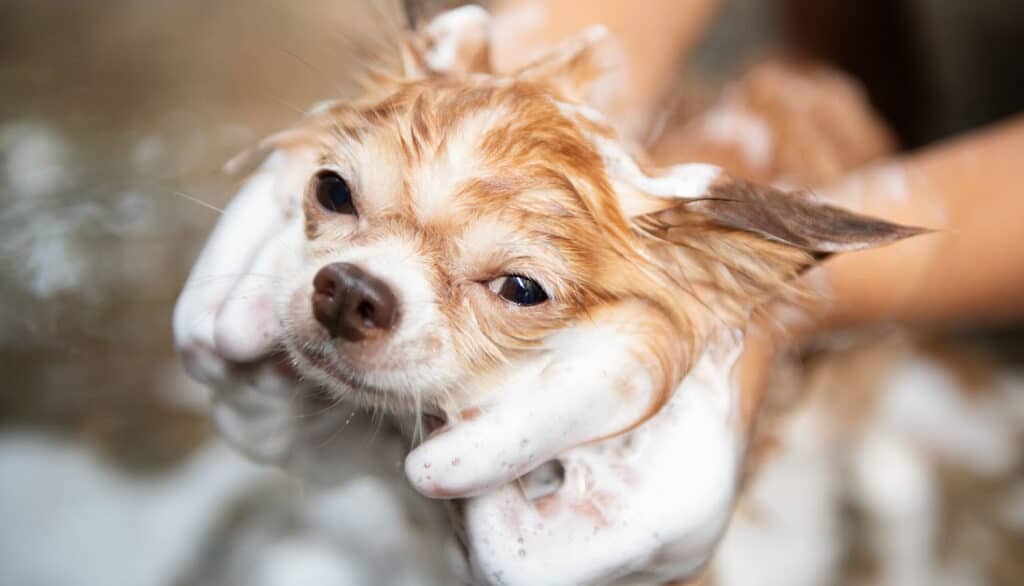
How to Make Your Dog’s Nail Quick Recede
Overgrown quicks in a dog’s nails can be problematic, not just because they increase the risk of accidental cuts during trimming, but also because they can cause discomfort for your pet. Thankfully, there are ways to encourage the nail quick to recede. Here’s how you can go about it:
1. Trimming Your Dog’s Nails
- Consistency is Key: Regularly trimming your dog’s nails can help the quick recede over time. It’s advised to trim a tiny bit off every 1-2 weeks, rather than waiting for the nails to grow long.
- Stay Within the Comfort Zone: While it’s essential to trim consistently, you should also ensure you’re not cutting too close to the quick. This can lead to pain and bleeding.
Pro Tip for Trimming Black Dog Nails
For those with dogs with black nails, finding the quick can be particularly challenging. Here’s a pro tip:
Feel the Texture: As you trim or grind the nail, pay close attention to the texture. When you get closer to the quick, the nail will become softer, and you might see a small dark circle in the middle. This indicates that you are approaching the quick, and it’s time to stop.
2. Natural Abrasion
- Walk on Pavement: Taking your dog for walks on concrete or asphalt can naturally file down their nails. The hard surface acts like sandpaper, gradually wearing the nail down.
- Encourage Digging: This might sound counter-intuitive, but setting up a designated digging area in your garden can help. As dogs dig, their nails rub against the ground, naturally wearing them down.
3. Nail Grinder (Dremel): The “Dog Nail File”
- Gradual Filing: Unlike clippers, a Dremel or nail grinder files the nail down gradually. This is especially useful for getting closer to the quick without cutting into it. Over time, as you use the grinder, the quick will start to recede.
- Safety First: Ensure the grinder has a safety guard to prevent going too deep. Also, keep sessions short to avoid overheating the nail.
- Desensitization: Before using a grinder, it’s vital to get your dog accustomed to the sound and sensation. Start with short sessions, rewarding your dog, and gradually increase the time as they become comfortable.
Encouraging the nail quick to recede requires patience and consistency. By regularly attending to your dog’s nails and understanding their anatomy, you can ensure they remain in top-notch health, reducing the chances of overgrowth and related complications.
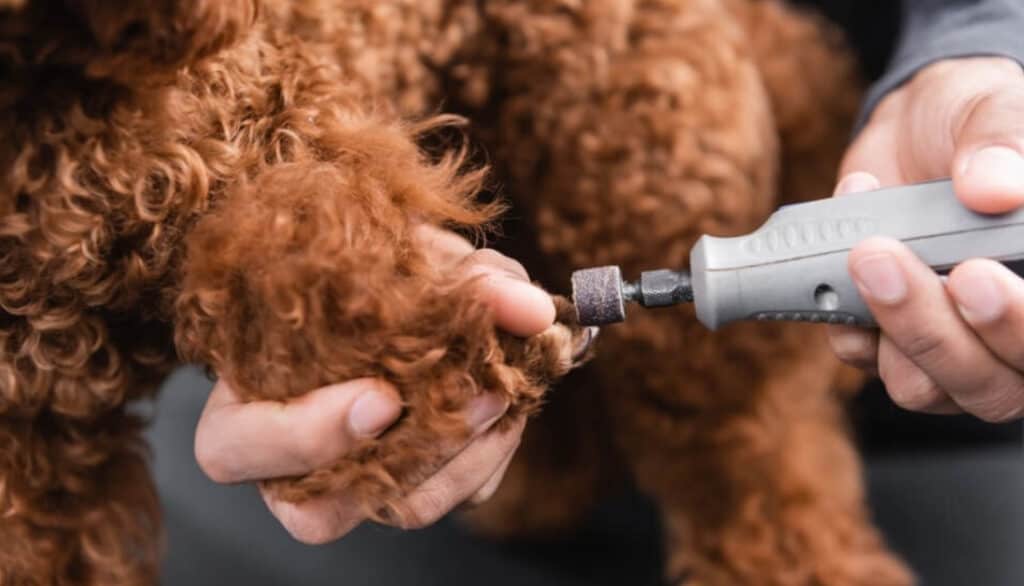
What if You Accidentally Cut the Quick?
It’s a moment every dog owner dreads. You’re in the middle of a nail-trimming session, and suddenly your dog yelps, or you notice a spot of blood. You’ve accidentally cut the quick. First things first, don’t panic. While it’s distressing for both you and your pet, there are steps you can take to remedy the situation.
1. Stay Calm and Comfort Your Dog
- Your Reaction Matters: Dogs often take cues from their owners. If you overreact, it can heighten their distress. Stay calm, speak in soothing tones, and comfort your pet.
- Provide Immediate Assurance: If your dog pulls away or looks upset, pause the trimming, and spend a few minutes comforting them. Offer treats or their favorite toy to distract and console.
2. Stop the Bleeding
- Styptic Powder: This should be a staple in your dog grooming kit. Upon contact with blood, styptic powder aids in clotting and stops the bleeding. Simply dip the bleeding nail into the powder or apply using a cotton ball.
- Alternative Solutions: If you don’t have styptic powder on hand, you can also use cornstarch or flour. Just press the dog’s nail into the substance, or apply it with a bit of water to make a paste.
- Avoid Touching Too Much: Once you’ve applied a clotting solution, try not to disturb the nail too much. The clotting process can take a few minutes.
3. Check for Signs of Pain or Discomfort
- Monitor Their Behavior: After the incident, keep an eye on your dog. If they continue to favor the injured paw, lick it excessively, or show signs of pain, it might be a good idea to consult your veterinarian.
- Provide Pain Relief: If you sense your dog is in discomfort, you can provide some relief. Always consult your vet before giving any medication to ensure the correct dosage and safety.
4. Reflect and Learn
- Assess the Situation: Understand what went wrong. Was it a lapse in attention, or do you need more practice identifying the quick? Use this as a learning opportunity.
- Seek Expert Advice: If you’re consistently struggling with nail trims, consider seeking the advice of a professional groomer or veterinarian. They can provide tips, or you might decide to let the pros handle the task in the future.
Accidentally cutting the quick can be distressing, but remember, it’s a mistake that many dog owners make. The key is to remain calm, act swiftly, and learn from the experience. With time and practice, nail trimming can become a smooth routine for both you and your furry friend.
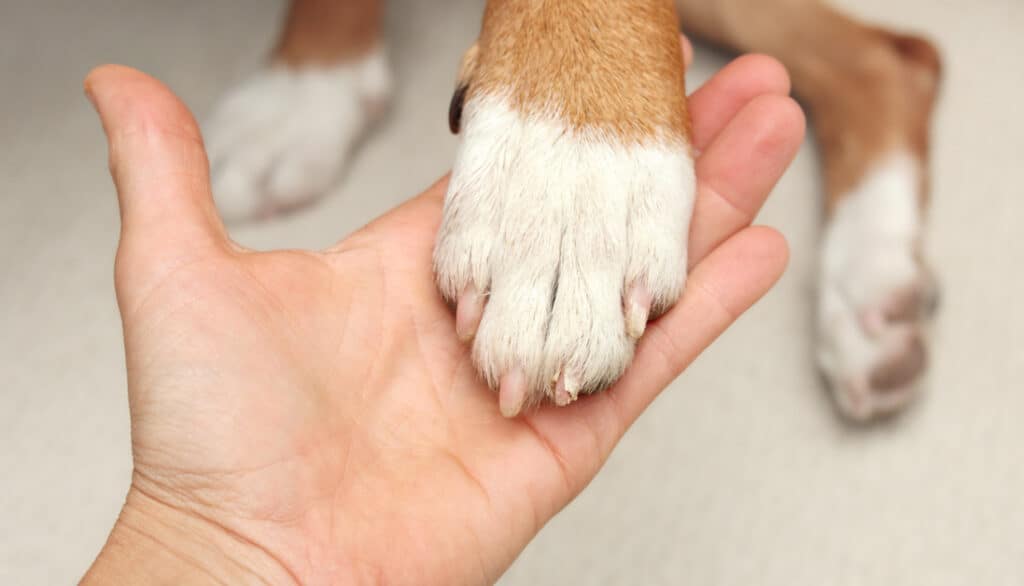
What Is the Perfect Length for Your Dog’s Nails?
Determining the ideal length for your dog’s nails is an integral aspect of pet care. Overgrown nails can cause a range of issues from discomfort to health problems, but how short is too short? Let’s delve into understanding the perfect nail length for our canine companions.
1. The “Floor Test”
- No Clicking Sounds: One of the most straightforward ways to gauge nail length is by listening when your dog walks on a hard surface. If you hear a clicking sound, it’s time for a trim.
- Flat Paws: When standing, your dog’s nails should not touch the ground. If they do, it’s a clear indication they’re too long. Ideally, nails should be just above the floor when your dog is standing on a level surface.
2. The “Look and Feel” Method
- Curve Point: Observe the nail. If you notice it starting to curve downwards, it’s an indicator that a trim might be due.
- Texture: As you get closer to the quick, the nail will feel softer and may start to look a bit spongy. This can help guide you on how much to trim without hitting the quick.
3. Considering the Quick
- Visible Quick: For dogs with transparent or light-colored nails, you can see the pinkish quick. Always trim approximately 2 millimeters away from it.
- Receding the Quick: If you’re trying to make an overgrown quick recede, remember the process is gradual. Trim the nails a little bit every week, allowing the quick to slowly pull back.
4. Breed and Lifestyle Considerations
- Active Outdoor Dogs: Dogs that spend a lot of time outdoors, especially on hard surfaces, may naturally wear down their nails. They might need less frequent trims compared to indoor dogs.
- Breed Specifics: Some breeds naturally have longer or thicker nails. For instance, Dachshunds often have longer nails, while breeds like the Boxer might have shorter, thicker nails.
5. Prioritizing Comfort
- Posture and Gait: Your dog’s comfort is the best indicator. If they appear to walk gingerly, are licking their paws excessively, or show changes in posture, it might indicate nail discomfort.
Achieving the perfect nail length is a combination of observation, understanding your dog’s lifestyle, and regular maintenance. It’s less about an exact measurement and more about ensuring your dog’s comfort and health. When in doubt, consult with a professional groomer or vet for guidance. With time and practice, you’ll develop a keen sense for what’s best for your pup!
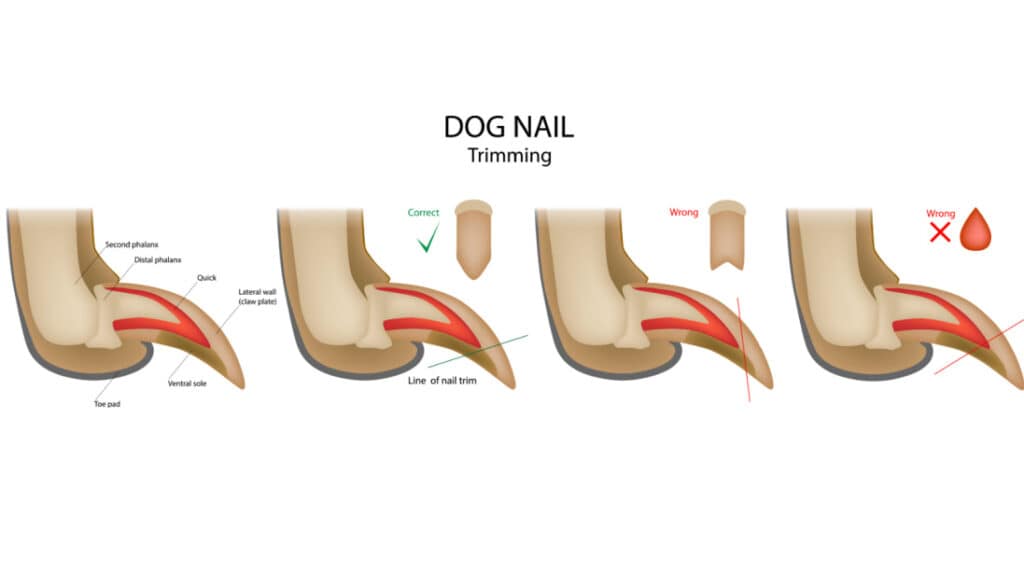
How Long Does It Take for the Quick to Recede?
A common question many pet owners have after understanding the importance of the nail quick is: how long does it take for an overgrown quick to recede? The answer isn’t straightforward, as several factors come into play. Let’s delve into the process of the quick’s recession and what influences its timeline.
1. The Basics of the Quick
- What Is the Quick? The quick is the tender, living part inside a dog’s nail. It contains blood vessels and nerves, which is why cutting into it can be painful and bloody for your dog.
- Why It Grows: If nails are not trimmed regularly, the quick tends to grow with the nail, making it challenging to clip the nails short without hurting your dog.
2. Factors Influencing Recession
- Age of the Dog: Younger dogs, especially puppies, have faster-growing nails, and their quick might recede more quickly with regular trimming than in older dogs.
- Nail Trimming Frequency: The more frequently you trim, the faster the quick can recede. For overgrown nails, trimming a little bit every week or every other week is recommended.
- Dog’s Activity Level: Active dogs that walk or run on hard surfaces may naturally wear down their nails. This can sometimes help in making the quick recede faster, as the nail gets shorter.
3. Average Recession Time
- Steady Process: On average, with consistent trimming (every 1-2 weeks), you might notice the quick starting to recede in about a month. However, for the quick to significantly pull back, it can take several months of consistent nail care.
- Individual Variability: Just as every dog is unique, the time for the quick to recede can vary from one dog to another. Some might experience faster recession, while others take longer.
4. Tips for Encouraging Quick Recession
- Regular Trimming: As mentioned, consistency is crucial. The more you trim, the more you signal to the quick to pull back.
- Nail Grinding: Using a nail grinder or Dremel tool can be an effective way to get closer to the quick without cutting it. Over time, this can encourage the quick to recede.
- Monitor and Adjust: Keep a close eye on the nails and adjust your trimming frequency based on how quickly the quick is receding.
Patience is essential when waiting for an overgrown quick to recede. While it’s a gradual process, with consistent care, you can help ensure your dog’s nails return to a healthy length. Always prioritize your dog’s comfort and, if in doubt, consult with a professional groomer or vet for advice on the best nail care practices for your pet.
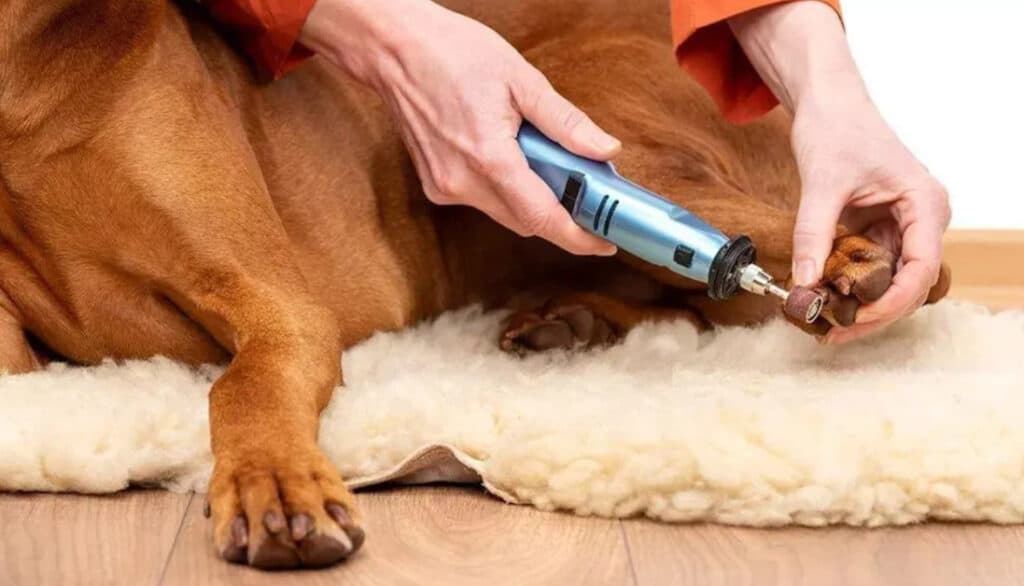
What if My Dog Is Afraid of the Nail Trimmers?
It’s not uncommon for dogs to be wary of nail trimmers. The sight, sound, and sensation can be unnerving for them. Add to that a past experience of accidentally cutting the quick, and it’s understandable why some dogs dread nail trimming sessions. If your dog is one of them, there are ways to make this essential grooming task less stressful for both of you.
1. Understand the Fear
- Past Experiences: If your dog has had an unpleasant experience with nail trimmers in the past, such as a painful quick cut, they might associate the tool with pain.
- Lack of Exposure: For some dogs, simply the unfamiliarity with the nail trimmers can cause anxiety. They might not understand what it is or what it does.
2. Gradual Desensitization
- Start Slow: Introduce the nail trimmers without actually cutting the nails. Let your dog sniff and inspect the tool. Praise and reward them for calm behavior around it.
- Short Sessions: Begin with short sessions, trimming only one nail or even just a part of one nail. Gradually increase the number of nails you trim in one session over time.
3. Positive Reinforcement
- Treats and Praise: Every time you trim a nail or even bring out the trimmers, reward your dog with their favorite treat and shower them with praise.
- Make it Fun: Turn nail trimming into a game or a bonding activity. For instance, trim a nail, then play a quick game or give belly rubs.
4. Consider Alternatives
- Grinding Tools: Some dogs might find nail grinders (like Dremels) less intimidating than clippers. However, introduce them slowly as the sound can be off-putting for some pets.
- Professional Help: If your dog remains fearful, it might be worth considering a professional groomer or veterinarian to handle nail trims. They have experience in calming nervous pets and can often complete the task swiftly and efficiently.
5. Create a Calm Environment
- Choose the Right Spot: Pick a quiet, comfortable place for nail trimming. Avoid areas with lots of distractions or noises.
- Stay Calm: Your dog can pick up on your emotions. If you’re anxious or stressed about trimming their nails, they will likely feel the same way. Breathe deeply, speak in soothing tones, and take breaks if needed.
6. Training and Familiarity
- Touch Training: Spend time daily touching and handling your dog’s paws without the intent to trim. This can help desensitize them to having their paws handled.
- Tool Familiarity: Leave the nail trimmers out in a common area where your dog can see and smell them regularly. This can help reduce the unfamiliarity and fear over time.
Building trust and creating a positive association with nail trimmers can take time, especially if your dog has had negative experiences in the past. Be patient, consistent, and always prioritize your dog’s comfort. Remember, the goal isn’t just to trim their nails but to ensure the process is as stress-free as possible for your furry friend.
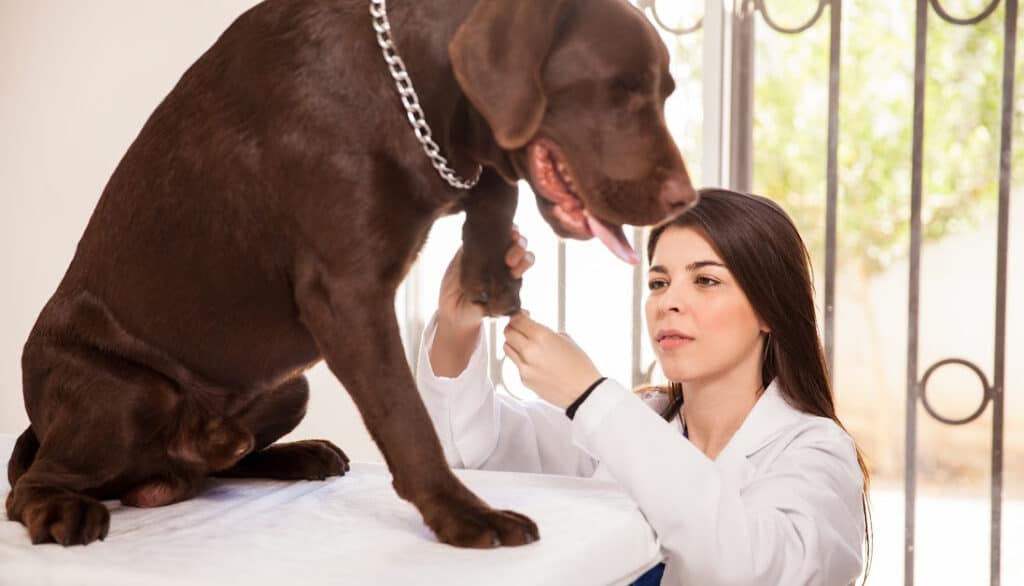
Consider Working With a Veterinary Professional
When it comes to your dog’s health and well-being, sometimes the best course of action is to seek the expertise of a veterinary professional. Whether you’re facing challenges with nail trimming, identifying health issues, or simply seeking guidance for routine care, vets and their teams bring a wealth of knowledge and experience. Let’s discuss the advantages and scenarios when you might want to collaborate with these experts.
1. Expertise and Experience
- Professional Training: Veterinary professionals undergo years of education and training to understand the intricacies of animal anatomy, behavior, and health.
- Handling Skills: They have experience in managing various dog breeds, temperaments, and specific health concerns, ensuring that procedures are carried out safely and efficiently.
2. Addressing Nail Trimming Concerns
- Overgrown Nails and Quick: If your dog’s nails are severely overgrown, a vet can guide you on safely trimming them back, possibly over multiple visits, while monitoring the quick’s recession.
- Fear and Anxiety: For dogs that are extremely anxious or aggressive about nail trimming, a veterinary clinic can provide a controlled environment, potentially using mild sedatives if deemed necessary and safe.
3. Health Evaluations
- Nail Disorders: Discolorations, thickened nails, or other abnormalities might indicate fungal infections, tumors, or other health issues that require professional attention.
- Post-Traumatic Concerns: If you’ve accidentally cut the quick and it becomes infected or isn’t healing properly, a vet can provide appropriate treatment and care advice.
4. Tools and Technology
- Advanced Equipment: Veterinary clinics are equipped with professional-grade tools that can address specific challenges, like high-speed nail grinders for thick nails or digital magnification for precision.
- Immediate First Aid: In case of unexpected injuries or complications, a vet clinic has the necessary first aid and medication on hand to address the situation immediately.
5. Educational Opportunities
- Guided Demonstrations: If you’re new to dog care or are unsure about nail trimming techniques, many veterinary professionals are happy to provide demonstrations and tips during your visit.
- Workshops and Classes: Some clinics offer workshops on topics like basic grooming, understanding dog behavior, and other pet care essentials.
6. Building Trust
- Consistent Visits: Regularly visiting the same vet helps in building trust. Your dog gets familiar with the environment, smells, and the people, which can reduce anxiety over time.
- Positive Reinforcements: Many vets use treats, toys, and positive reinforcement techniques to make the experience more pleasant for your pet.
Working closely with a veterinary professional doesn’t just ensure your dog’s physical well-being; it also provides peace of mind. You’ll know that you’re making informed decisions, using the best techniques, and accessing expert advice whenever needed. Whether it’s for routine care, addressing specific challenges, or emergency situations, establishing a good relationship with a vet is invaluable for every responsible pet owner.

Utilizing Dog Groomers
While veterinary professionals are essential for health-related concerns, dog groomers are the go-to experts when it comes to keeping your dog looking and feeling their best. These trained professionals specialize in the aesthetic and hygiene aspects of dog care, ensuring your pet is both clean and comfortable. Let’s explore the benefits and scenarios when turning to a trusted groomer might be your best bet.
1. Expertise in Grooming
- Skilled Techniques: Dog groomers are trained in the art of grooming, understanding the different coat types, breeds, and the best approaches for each.
- Tailored Services: Whether your dog needs a simple bath, a detailed trim, or specific styling, groomers can provide a range of services tailored to your pet’s needs.
2. Nail Trimming and Beyond
- Specialized Tools: Groomers are equipped with a variety of nail trimmers and grinders suitable for different nail types and sizes.
- Quick Identification: Experienced groomers can easily identify and avoid the quick, ensuring a painless experience for your dog. They’re also adept at handling minor bleeding instances, should the quick accidentally get nicked.
3. Bathing and Skin Care
- Correct Products: Groomers know which shampoos and conditioners are suitable for different coat types, and can address specific issues like dry skin, ticks, or fleas.
- Thorough Cleaning: Areas that owners might find tricky to clean, such as the ears or under the tail, are all in a day’s work for groomers.
4. Styling and Haircuts
- Breed-Specific Cuts: From Poodles to Shih Tzus, every breed has its specific look. A professional groomer knows how to trim and style your dog to match breed standards or your personal preferences.
- Seasonal Styles: Whether it’s a summer shave to keep your dog cool or a winter trim that still offers some protection against the cold, groomers can adjust their techniques based on the season.
5. Safe and Comfortable Environment
- Designed for Grooming: Grooming salons are designed with the safety and comfort of pets in mind. Slip-resistant surfaces, adjustable tubs, and specialized drying areas all contribute to a positive grooming experience.
- Distraction Techniques: Many groomers are skilled at distracting anxious pets with treats, toys, or soothing sounds, making the process smoother.
6. Detecting Abnormalities
- Observant Eye: While groomers aren’t a replacement for vets, their hands-on approach means they often spot issues like skin infections, lumps, or parasites early on. This can be invaluable for early intervention.
A reputable dog groomer is more than just a luxury; they’re a valuable resource in your pet care toolkit. Regular grooming sessions can improve your dog’s comfort, reduce health risks, and even strengthen the bond between you and your pet, as they return home looking and feeling refreshed. When choosing a groomer, always check reviews, ask for recommendations, and ensure they have the appropriate certifications or training. Your dog deserves the best!

Conclusion
Navigating the realm of dog nail care can seem overwhelming, with its unique set of challenges and a myriad of techniques to master. But at the heart of it all lies a simple truth: our dogs rely on us for their comfort and well-being. Whether you’re meticulously mastering the art of nail trimming at home, seeking the expert touch of professional groomers, or consulting with trusted veterinary professionals for those intricate concerns, each step you take is a testament to the love and care you hold for your furry friend.
Remember, every dog is unique, and what works for one might not work for another. It’s about finding the rhythm that suits both you and your pet, ensuring that their tails keep wagging and their paws stay prancing happily. With patience, consistency, and the right knowledge at your disposal, nail care can transition from a daunting chore to a rewarding routine.
As you journey through the ups and downs of pet ownership, always cherish the moments of joy, learning, and growth. After all, our dogs offer us unconditional love, loyalty, and a lifetime of memories. Ensuring their comfort, one nail at a time, is just one of the many ways we can give back.
Thank you for joining us on this comprehensive dive into dog nail care. We hope this guide empowers you to make the best decisions for your beloved pet. Happy grooming! 🐾
Frequently Asked Questions (FAQs)
While the exact frequency can vary based on your dog’s activity level and the surfaces they walk on, most dogs will benefit from a nail trim every 3-4 weeks. Monitor your dog’s nails regularly to determine the best schedule for them.
First, don’t panic. It can be distressing for both you and your dog, but it’s a common mistake. Apply styptic powder or cornstarch to the bleeding nail to help stop the bleeding. If it continues to bleed heavily or shows signs of infection, consult your veterinarian.
You can try desensitizing your dog to the process with positive reinforcement or consider alternative tools like nail grinders. If your dog remains extremely anxious, it might be best to consult a professional groomer or veterinarian who can safely trim their nails for you.
While it’s technically possible for very small dogs or puppies, it’s not recommended. Dog nail clippers are designed specifically for the thickness and shape of dog nails. Using human nail clippers can cause splintering or uneven cuts.
A good rule of thumb is that if your dog’s nails touch the ground when they walk, they’re too long. Ideally, dog nails should have a slight clearance from the floor. Additionally, long nails can cause discomfort or lead to posture issues, so regular checks are essential.
